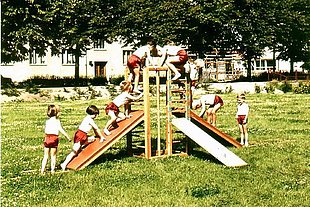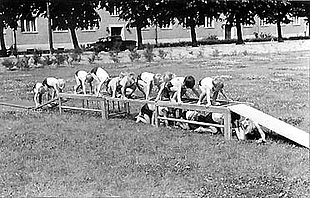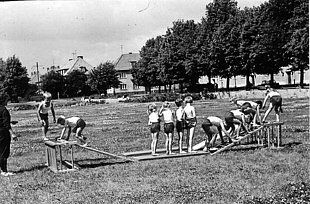History
The Multipurpose Kids Gym Apparat “Greifswald”
- the development of the motoric skills by training the conditional abilities like power, quickness and endurance as well as the coordinative abilities like nimbleness, mobility and agility
the training of basic movement abilities and the combination with complex movement activities like crawling, pulling, pushing, rising, balancing, rolling, resting on something, jumping, climbing, brachiating, swinging, poking, throwing and catching.
In addition the apparatus should meet the following requirements:
- to have several apparatus, which could be combined in the modular conception
- to be constructed and deconstructed quickly
- to offer multifarious exercises
- to be used from several children at the same time
- to provide the needed standing safety
- to guarantee an uncomplicated transport (of the single parts)
- to offer good value for money
- to store it with only little measurements in the smallest room
Based on these thoughts I developed a multipurpose apparatus that consisted of the following parts:
- two basic apparatus (a tower like combination of steps, ladders and climbing poles), lids, ladders, slides, parallel bars, basketball hoops and safety standing beams that can be put together to a balance beam
- a rack for the installation of the balance beam, a high jump- or volleyball net for children and two suitable fixing devices.
Every second step wasn't fixed tightly, but screwed in with a thead. It could be easily removed and be used as another gymnastic bar.
The separate parts of the gymnastic apparatus were made to fit exactly into each other. Therefore the combined apparatus was only 160 cm long, 60 cm wide and 100 cm high. It was made of ash wood and was made waterproof with a colourless paint coat. The padded lid was covered with red artificial leather.
The kids gym apparatus respectively the separate parts could be used multifarious, e.g. as a jungle gym in flat-, side- or upright position, wall bars, gymnastic bar, balance beam with 8 cm and 15 cm width, gymnastic bench, climbing pole, ladder in sloped or horizontal position as well as like a hand apparatus, twin ladder, slide, jumping board, horizontal bar, twin bars, parallel bars, uneven bars, boxes in longitudinal- or crosswise position as well as in a sloped or a horizontal position, basketball hoop, aim throwing ring, volleyball net for children respectively high jump net. The large variety of exercises could be enlarged by varying the heights of the apparatus.
The volleyball net for children respectively the high jump net was 250 cm long and 15 cm wide. It could be used as a barrier when throwing the ball and setting as well as for preliminary practises for volleyball. Also the net could be used for the high jump instead of the usual narrow string or bar. The children could make out the height they had to overjump more easily.
Supported by the national committee for physical culture and sports the VEB factory for gym apparatus “Fanal” produced the first apparatus in Karl-Marx-Stadt in 1962. They were successfully tested by the institute for physical education and the kindergarten of the University of Greifswald as well by the institute for movement education of the German academy for body culture (DHfK) in Leipzig. The director of the last mentioned institute, Prof. Dr. Kurt Meinel, expressed his first impression as followed: “The kids gym apparatus ‘Greifswald’ is first-rate suitable for a multifarious and target-orientated training of the movement abilities and skills of kids in the preschool age. A particular advantage is the multipurpose use; it can be used as a jungle gym, wall bars, gymnastic bench, horizontal bar, parallel bars, box, ladder etc. Therefore in addition to offering many different movement impulses, it makes a joyful and diversified moving around and practising for several children at the same time possible as well.
First the apparatus was meant to be exhibited on the Spring Fair in 1962. Since I wanted to make some adjustments, “Fanal” declined the presentation at that time. On the occasion of the 1st Scientific Conference of the GDR for problems of the physical education in the elementary school the apparatus was presented on the 9th July 1962 in Greifswald for the first time. On the 14th of February 1963 the national committee for body culture and sports informed in a press release, that after months of testing the apparatus is ready to be presented on the Leipziger Spring Fair as a test pattern. On the same day the sports desk of the “General German News Service” (ADN) published the message, that I demonstrated the multifarious usability of the apparatus in kindergartens and schools with several groups of children in the factory of the manufacturer in front of educationists and representatives of the press: “Eleonore Salomon who mainly works as a historian, occupied herself in her free time with the precious new development, in which she evaluated her experiences that she gathered while her practical work in preschool facilities.”
Three weeks later, the 8th March 1963 the ADN informed: “As expected, the new developed ... multipurpose gym apparatus ... designed by the scientific assistant became an attraction. Daily in the morning and in the afternoon there's a big crowd in the Leipziger Bruehl, where preschool kids show their skills on the testing apparatus under the supervision of scientific staff members of the DHfK ...”1 And under the keyword “production starting in 1964” the production manager Kreher from the “Fanal”-factory explained to the news service: “our first experiences with the kids and the first applications from Sweden, Belgium as well as from kindergartens, schools, living groups and holiday homes of the GDR show, that this apparatus has a great perspective.”
The newspaper “FÜR DICH”, no. 25/1963, dedicated the demonstration of the apparatus in the shop windows of the Leipziger store at Bruehl a double sided photographic report with the title: “A thing with a kick”. Furthermore all daily newspapers of the GDR reported about the apparatus, some of them several times. Of course, the national radio GDR I and II and the German TV show “Sport-Mix” informed about it as well. Even the “Austrian voice of the people” printed a photographic report on the 31st August 1963 (months later) about the demonstrations of the apparatus on the Spring Fair.
On Sunday, the 31st March 1963 I gave some preschool kids from the Berlin-Johannisthal home the opportunity to practice on the apparatus in the TV show with “Meister Nadelöhr and Heinz Quermann” and then again on the 13th July 1963 in a TV show for the Baltic Sea week in Rostock. The record of that broadcast from Berlin doesn't exist anymore; the one from Rostock is only two minutes long. The apparatus was presented in action while the 4th German gymnastic- and sports festival 1963 and got ovation from the audience: guests from the Czech Republic, Belgium, France, the United Arab Republic and some young African states.
During the Spring Fair in Leipzig in 1963 200 orders were placed. Since 1964 the patented apparatus was manufactured by a Thuringian company. At the end of 1964 and beginning of 1965 58 preschool facilities of the GDR received the apparatus from the Administration for national education as a prototype for further testing. After 8 to 12 months 34 kindergartens reported about their predominantly positive experiences but criticised some production deficits as well (the report is available).
Since 1962 I led many advanced training seminars for kindergarten teachers for the regions in and around Rostock and Neubrandenburg in agreement with the research team for preschool physical education at the Institute for movement education of the DHfK and the speciality department of the Administration for national education. I presented the multipurpose apparatus in several journals of the GDR like “Körpererziehung” (Physical education), “Neue Erziehung im Kindergarten” (New education in kindergarten) and “Wissenschaftliche Zeitung der Ernst-Moritz-Arndt-Universität Greifswald” (scientific journal of the Ernst-Moritz-Arndt-University Greifswald).
Even foreign journals reported about the apparatus: Prof. Dr. F. Kratky from Prague reported with word and picture in no. 8/1964 of the Czechoslovakian journal “Predskolská výchova”, Dr. N. Petrova in no. 4/1964 of the Bulgarian journal “Wiprosi na fisitscheskaja kultura” and L. Koltschewskaja and W. Sawelewa very detailed in 4/1966 of the Soviet “Doschkolnoje wospitanie”. The Polish “Wychowanie fizyezne i higiena szkolna” 5-6/1969 published after short comments of the editorial team 14 pictures of exercising children in different positions of the apparatus.
Since 1963 the kids gym apparatus “Greifswald” was a regular exhibit of the GDR Fair for sport goods. On the 3rd September the “Deutsches Sportecho” reported about the “Expotiva 69”, a fair in the beginning of September 1969: “Under a large and orange-coloured tent with open sites there's the multipurpose apparatus ‘Greifswald’ in 12 different variations.” The daily newspaper “Neues Deutschland” had still called it a “hit” the day before. And the head of government added: “This one here is very good.”
Since the seventies the apparatus belonged to the basic equipment of the GDR- kindergartens.
A complete set, consisting of two basic apparatus did cost 870,30 Mark of the GDR. Unfortunately there aren't any numbers neither of the total production nor on the export. But 300 apparatus were delivered to Havana. Dr. Gerhard Lewin confirmed that delivery - he was the head of the Institute for swimming at the DHfK from 1953 to 1968 and was delegated to Cuba by the swimming association of the GDR to advice Cuban coaches from 1974 to 1976 - together with his wife Käthe. The two of them had just arrived in this central American country, when there was a considerable mishap with the delivery: The apparatus was shipped without the 42-sided illustrated material, that didn't just show the usage of the apparatus, but also contained many instructions for practising. I even had the instructions translated into English and Spanish.
Until 1989 the apparatus was produced in large numbers and sold through the central shopping agency for sports goods that was located in Berlin, preferentially to kindergartens. It was mainly exported to socialist countries, main customer was Hungary with annually 400 exemplars (the exact period is unfortunately not known).
Because of the new requirements of the law through the norm EN 71 the Thuringia factory developed the kids game- and gymnastic apparatus “Geschwenda” in 1990 out of the kids gym apparatus Greifswald that was sold to kindergartens, schools and communities. The business built 200 apparatus every year. In 2000 the demand had ceased and so it wasn't produced any more. The producer had changed the size of some parts, so that the modular conception was lost and new parts were added like bottom plate with felt, rope, solar sail (!), and ball throwing area and a covering for a puppet stage (!).
Unfortunately the kids gym apparatus “Greifswald” wasn't in my possession, so that I couldn't provide it to the Leipziger sports museum. Instead I gave the additional publication for the apparatus as well as some documents in German and English to the facility. In some kindergartens these apparatus do probably still exist today, in others maybe only parts of it. According to a study in 2000 about movement, sports and games in twenty kindergartens in Greifswald, 50 % of these facilities still used the multipurpose apparatus. In a kindergarten in Pirna I discovered a basic apparatus but the separate parts like ladders, slides etc. were missing. Maybe the complete apparatus for the sports museum in Leipzig could be put together using the separate parts from several facilities.
Dr. Eleonore Salomon
translation of an article in the magazine of the sports museum in Leipzig, issue 2-3/2005
note:
1Assistants of the research team for preschool children gymnastics from the Institute for movement education of the DHfK demonstrated the multifarious possible applications of the apparatus during the spring fair in 1963 daily from 10 to 12 o' clock and from 15 to 17 o' clock in the shop windows of the Leipziger store at Bruehl with preschool kids gymnastic groups.














